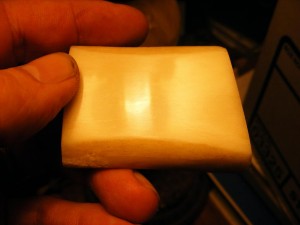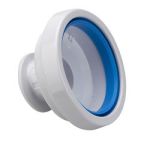Scrimshaw can be performed on any hard material that will hold a contrasting pigment. Scrimshaw on bone handled knives as well as bone cabochons or beads are popular alternatives to ivory, and there are plenty of materials out there.
Bone is a naturally porous material which will take on moisture and oils as well as expand and contract with the variations in temperature and humidity. It is best to either find a stabilized source or to stabilize it yourself before you take the time to ply your craft.
Stabilized bone can be found in most knifemaker supply houses as either cow bone, camel bone or in some cases other “bush meat” bone that has been cleaned and preserved.
You can find blank material to work on in several places depending on your end product. Amazon has bone blank
bone knife scales from time to time, and there are also buffalo bone nut blanks often used in the luthier trade. You can sometimes find them oversized which works well for smaller knife handle material or for creating cabochons or inlay.
As to the material when it comes from the source, unless it clearly states that it has been or is stabilized, figure that it is not, and it will be porous. There are several ways you can stabilize or seal them yourself, or you can re-ship them out to a stabilizing service – they often do the same for bone, antler, spalted wood, etc.
Stablilizing Bone for Scrimshaw – top coat:
- The first Method requires dry bone cut roughly or completely to the shape intended,
- cyanoacrylate glue (super glue like Loctite
or Bob Smith 103
)
- small paint brushes – don’t use good ones, get cheap ones you can throw away or use q-tips
- Newspaper to cover the area you’ll be working on.
- gloves
- ventilation
- eye protection
Coat the piece you intend to scrimshaw by squirting the glue on then coating the rest of the surface using the brush. Let the piece dry.
Once dry, sand it down lightly so it’s smooth. We tend to use 320 grit sandpaper then wipe off any dust and recoat it. Second time we sand it we move up to a 600 grit and inspect it carefully. Sometimes two coats is all you need to fill in any voids. If it’s good, we work up to 3000 grit, then a polish with HUT wax and start to scrim.

Stabilizing Bone for scrimshaw – method 2: Immersion
We tried this using Minwax Wood Hardener and came up with useable but “antiqued” looking bone and tagua nut buttons. They ended up with a yellowish patina. In this method you’ll use a glass mason jar or ball jar with the vacuum type lid, you will be standing the jar upright and immersing your pieces in either the Minwax wood preservative or a mixture of acetone and duco cement as mentioned in http://www.artifactsguide.com/discus/messages/12/11427.html?1071787182
Either one should be done in a well ventilated area with no open flames sparks etc. Realize also that any rubber or plastic (like the wine stopper and the lid) will disintegrate – wear gloves when removing it and discard appropriately.
I used a Vacu Vin, drilling a hole into the top of the metal ball jar lid that fit the stopper almost perfectly.
 Another way to accomplish this would be to use a FoodSaver T03-0006-02P Regular-Mouth Jar Sealer
Another way to accomplish this would be to use a FoodSaver T03-0006-02P Regular-Mouth Jar Sealer which may last longer if you can remove it quickly enough.
Here’s a video of someone stabilizing some material similar to what we’ve just described:
https://www.youtube.com/watch?v=sx5BW-aAR1I
Here’s another one from another individual:
https://www.youtube.com/watch?v=-DfZXM2B51Q
Pre-stabilized bone can be found in cow, camel and giraffe, though many times it is died or “jigged” – where a pattern is cut into it to allow for a better grip. Texas KnifeMaker’s Supply has some nice supplies including cow,
Here are several links to knives you can scrimshaw. Most have bone handles from Amazon.com:



Good article. Found this on a Google search, how to stabilize bone.
Looks like a lot of work. Might have to try the Gorilla super glue.
Tried to super glue bone powder into the Pitts, didn’t work.
Hi Rich, and thanks for writing! I’m planning on another couple of experiments since I found the crazy glue was indeed a lot of work for minimal results. Hope to have more information for the next newsletter. Gorilla glue tends to bubble in the presence of water, but it may work. I’ll keep you posted if I find a better solution.
I have worked straight onto antler with only a good sanding then a good coat of beeswax polished up then scrimed the wax stops any bleeding of the pigment works lovely even on bone have you tried this old school method
Thanks Adam, I’ve still got some antler I hope to work on in the fall for some jewelry pieces, and I’ll try the bees wax. Waiting for some buffalo horn to come in so I can try that – some of the other artists have created beautiful works in it. Purchased some cattle hoofs (same material: keratin), but after I got it home it looks like it’s going to be a lot of work and some boiling (if the dog doesn’t get them first!) to get them into a usable shape. Thanks again for the tip! If you have any pics you’d like to share, I’d love to see them and will be happy to post them on the site under the artists page for you.
I’m new to scrimshaw and have only done one small project so far. I’m wondering if Tung oil would work to stabilize bone. If not, why? Thank you for your time in advance,
-Smits
Hi Smits, and thanks for writing! Tung oil is used as a drying agent, but it also leaves a fine finish on woods and other materials. We haven’t tried it on bone or any other material though it sounds as if it may work well on tagua nut. The only downside I’ve read so far is that it may yellow with age. Often the stabilizing process involves pressure or placing the material into a vacuum chamber to remove the excess air from within the material. We’d be interested if it would work for bone in this fashion. Usually a plasticizer is used along with acetone to dissolve it, though professional preservers and stabilizing companies use proprietary mixtures. We’d love to see what you’ve done and let us know the outcome if you take on the experiment!
First, I’d like to say thank you for responding in such a timely and informative way. Second, I’ve taken a small(to small to scrim) sliver of bone from another project and have sanded with graduating grits until smooth, then I applied the tung oil straight from the can. I’m waiting for the oil to cure to check results. I’ll have more info then, but I’m hoping. Sidenote, If my piece yellows after awhile on it’s own then it will save me a step as I was looking for ways to “age” my project for a specific effect I’m looking for. If it does I’ll let you know.
Findings: The Tung oil sealed the surface micro pours well, it repelled casually spilled paint (Oil/Acrylic? I’m not sure what kind.), And adds some hardness to the bone (which is good for accident forgiveness). The one thing that is really obvious is the marble patina and slight shine that the oil gives to the piece. It looks like old ivory when you’re done with it. I haven’t tried diluting with a thinner of any sort or adding pressure treatment, if i had the set-up it would be an interesting thing to find out how it reacts.
Again, thanks for the response and help. I hope this is of interest to you.
-Smits
Thanks for sending in your findings, Smits! I’ll have to try Tung oil myself on a bone knife handle or something similar, or feed our dog a soup bone to clean then slab it and test it out. We really appreciate the tip. If you get a chance, send a picture or two to “questions@scrimshaw.com” – we’d love to see the results!